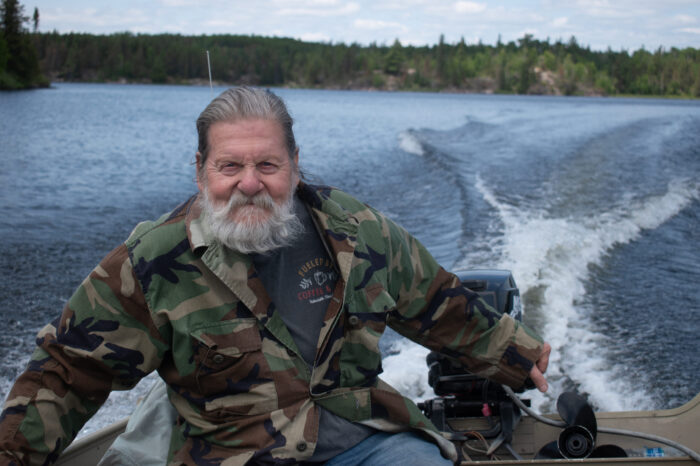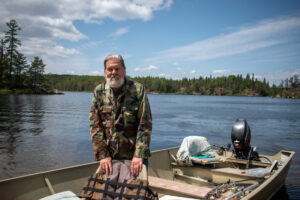Life on the Seagull River: Dewey Pihlman’s story of resilience along the Gunflint Trail
The Gunflint Trail has long drawn people in search of solitude, adventure, comfort, a connection to the outdoors, or a life lived on their own terms.
Near the end of the 57-mile road, which winds through towering white pines and the dense boreal forest, Dewey Pihlman has made his home for decades along the Seagull River in a cabin only accessible by boat.
The cabin, with electricity and broadband but no running water, offers Pihlman a sense of remoteness, solace, and self-reliance.
The Seagull River is a scenic waterway flowing near the Boundary Waters Canoe Area Wilderness and Saganaga Lake. It serves as both a gateway for paddlers entering or leaving the BWCAW and a route for a small number of cabin owners and outfitters who rely on the river to access their homes and businesses.
At 85 years old, Pihlman has spent decades living by the rhythm of the northern seasons and the Seagull River.
It is where Pihlman has built his life, a life shaped and sometimes tested by the land and the water that surround him.
“It’s been wonderful living here all these years,” said Pihlman.
Pihlman bought his property on the Seagull River in 1980 and began building his home shortly after in 1982. Throughout the decades, he has divided his time between living in the cabin, taking some years off to return to work, and, in his early 70s, attending college in Duluth.
Throughout the year, Pihlman’s days move at the pace of the wilderness. He tends to chores, watches wildlife, visits with neighbors, and, depending on the weather, makes the occasional trip to Grand Marais for supplies. With his cabin only accessible by boat, Pihlman leaves his vehicle parked across the Seagull River at Voyager Canoe Outfitters.
Depending on the season, Pihlman will use his boat to motor across the river to his vehicle and then make his way down the Gunflint Trail to Grand Marais, Duluth, or beyond. In the winter months, he uses the snowmobile or four-wheeler to travel across the frozen river to access his vehicle.
During the seasonal transition months, however, such as April or November, his mode of transportation looks a little different.
“When the bad weather comes, things are rapidly changing,” Pihlman said. “Freeze-up is unpredictable.”
Relying on the conditions of the Seagull River for travel has come with its challenges. There was a time recently when Pihlman was unable to leave his house for 27 days, trapped by the changing seasons and unsafe conditions on the river.
With numerous hobbies like photography, making jewelry, working on the cabin, or spending time with his loving cat, Henry, Pihlman keeps himself busy during those long stretches.
“My days can be real, real busy,” Pihlman said. “And then again, I’m a good procrastinator. I can find any way possible to do absolutely nothing.”
Even after more than 40 years living on the Seagull River and a deep knowledge of its rhythms, Pihlman knows the river demands respect, and that danger can appear in an instant. While there is immense beauty in the remoteness of where he lives, it is also accompanied by risk.
In April of 2024, he learned this firsthand, a moment that nearly cost him his life.
On April 9, Pihlman had plans to travel to Grand Marais for a doctor’s appointment at North Shore Health. Ice still covered the Seagull River, and rather than take his four-wheeler across the lake, he decided to walk instead, opting for some exercise.
He left his ice picks hanging on his four-wheeler but grabbed a knife attached to a thick string, which he draped around his neck.
“The ice was hard,” Pihlman said. “I’m watching what I’m doing. I’m thinking about the trip to town and a million other things.”
As he neared the landing at Voyageur Canoe Outfitters, about 50 feet offshore, Pihlman went through the ice.
“Within a second, I went right through. I crashed right through into deep water over my head,” he said. “I clawed my way up to the top, and I got a hold of the ice.”
Pihlman grabbed the knife hanging around his neck and stuck it into the ice. He held onto the knife while trying to kick his feet and crawl up on top of the ice. But he wasn’t able to get himself out of the water.
“I couldn’t get up over that edge,” he said. “It kept breaking away.”
He quickly realized he wasn’t going to get out of the cold water without help. He started yelling, but with it being April, a slower time of year up the Gunflint Trail, he knew there wasn’t much help around.
“I yelled help at least 100 times,” Pihlman said. “I knew I was helpless.”
Pihlman said he thinks the water temperature on that day was approximately 40 degrees. He knew that he was racing against the clock before severe hypothermia would set in.
After being in the water for 10 to 15 minutes, Pihlman’s neighbor from across the river, Paul Zak, heard his cries for help and immediately made his way to Pihlman. Fortunately, Zak was able to pull Pihlman out of the water without breaking through the ice himself.
As soon as Pihlman was out of the water and on safe hard ice, Zak ran to Voyaguer Canoe Outfitters to search for more helping hands. Pihlman was then put on a four-wheeler and brought back to the outfitter. He was stripped of his clothes and put in the hot shower while staff called 911. Staff and first responders heated blankets in the microwave and tried their best to warm Pihlman as fast as possible.
When the EMTs took Pihlman’s body temperature, it was 84.5 degrees. At that temperature, severe hypothermia becomes a significant concern, as the heart, nervous system, and other organs may no longer function properly.
Later that day, and after a CT scan at North Shore Health to confirm he wasn’t injured or in need of medical care, Pihlman was released from the hospital. But in his mid-80s, the road to recovery takes a little longer. He spent the next few months slowly recovering from the experience, mentally and physically.
Pihlman, who has over four decades of traversing the Seagull River, said the incident serves as a reminder that even the most experienced can make a mistake.
“I’ve been doing that on that ice, on that river for so many years. I know everything about it. But we make mistakes,” he said.
He said his advice to others traversing ice, regardless of the conditions, is to “be thinking about what you’re doing and watching what you’re doing. Paying attention.” Pihlman said he also regrets not having his ice picks with him that day, as he believes he may have been able to get himself out of the water. “I’m reasonably sure I could have gotten out.”
Looking back on the experience, Pihlman said, “It’s a miracle I never froze.”
“I’ll tell you what, when I was in the water, God had his hand on me, and I know that to be. I really believe that God had his hand on me one more time,” he said.
WTIP’s Kalli Hawkins visited Dewey Pihlman at his cabin this summer to learn more about his life on the Seagull River, the life-threatening ice accident in April 2024, lessons learned, and more. The audio is below.


















